If you’re curious about industrial processes and the massive machines that make modern conveniences possible, you’re in the right place. Today, we’re going to shed some light on an unsung hero of the industrial world – the cooling tower.
What is a Cooling Tower?
You might be asking, “What exactly is a cooling tower?” Simply put, a cooling tower is a heat-rejection device. It takes waste heat from industrial processes and releases it into the atmosphere, typically using water and an evaporation process to carry away the heat. It’s like giving the industry a giant air conditioner.
It is a fundamental component in numerous industrial applications, providing a reliable source of cool water throughout the year. Ideal for operating temperatures ranging from 70°F to 100°F(21.1 °C to 37.8 °C), these devices are instrumental in dissipating unwanted heat from various processes and machinery. Industries leveraging this technology include but aren’t limited to, injection molding, food and beverage, chemicals, laser systems, machine tools, semiconductors, and more.
Despite the varying designs and manufacturers, the core operating principle of all cooling towers remains constant: evaporative cooling. This universal mechanism forms the crux of how these systems function, making cooling towers an indispensable asset in industrial cooling needs.
Components of a Cooling Tower
Now, let’s break down the cooling tower into its major components like we’re taking a guided tour inside this impressive machine:
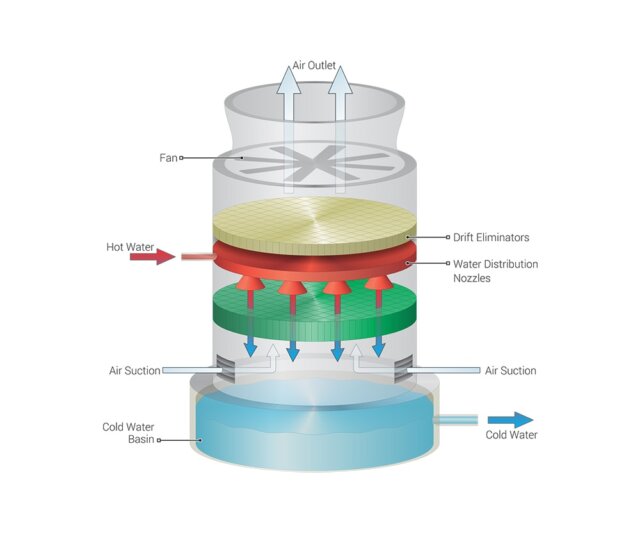
- The Frame and Casing: This is the tower’s structure, usually made of robust material like metal or fiberglass.
- The Fill: This is where the action happens. The fill increases the contact area between the air and the water.
- The Cold Water Basin: This collects the cooled water at the bottom of the tower, where it’s sent back to cool the industrial process.
- The Drift Eliminators: These guys capture water droplets that could be carried away with the escaping air.
- The Fans: These are the unsung heroes. They draw air through the tower, aiding the evaporation process.
The Process: How a Cooling Tower Works
Now, onto the fun part – how a cooling tower works. It’s pretty ingenious, really:
- Warm water from the industrial process enters the cooling tower.
- The water is spread inside the tower, typically over the fill, to increase its surface area.
- Fans pull air through the tower, and this air evaporates a small portion of the warm water.
- This evaporation cools the remaining water, which is collected in the basin.
- The cooled water is then pumped back to the industrial process, and the cycle begins anew. Neat, huh?
Types of Cooling Towers
There are a few types of cooling towers, each with their unique twist on the process:
1. Counterflow Towers
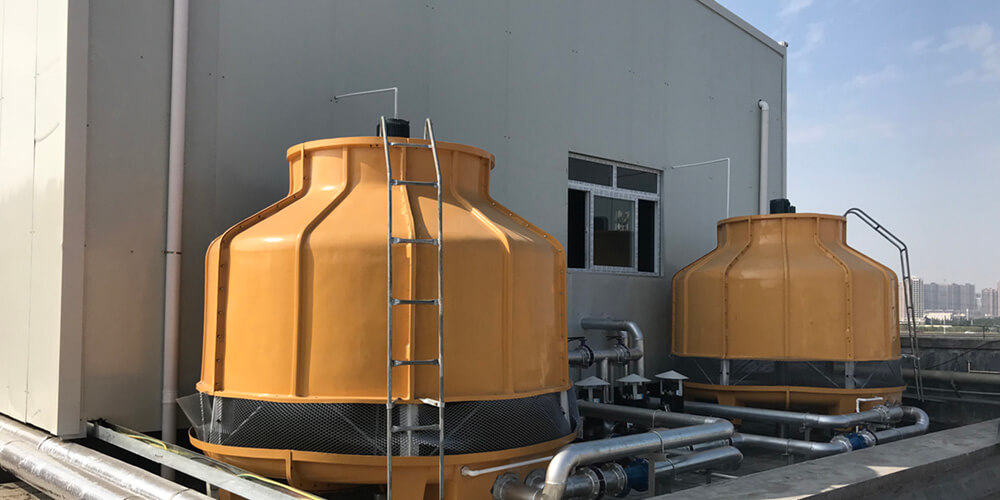
In a counterflow design, the air is directed vertically upward, moving against the flow of the falling water. This configuration is compact, offering a smaller footprint compared to other designs. This makes it a good choice for locations where space is at a premium. However, due to the air and water moving in opposite directions, counterflow towers typically require more powerful, and thus more energy-consuming fans, to overcome the resistance of the upward air movement.
2. Crossflow Towers
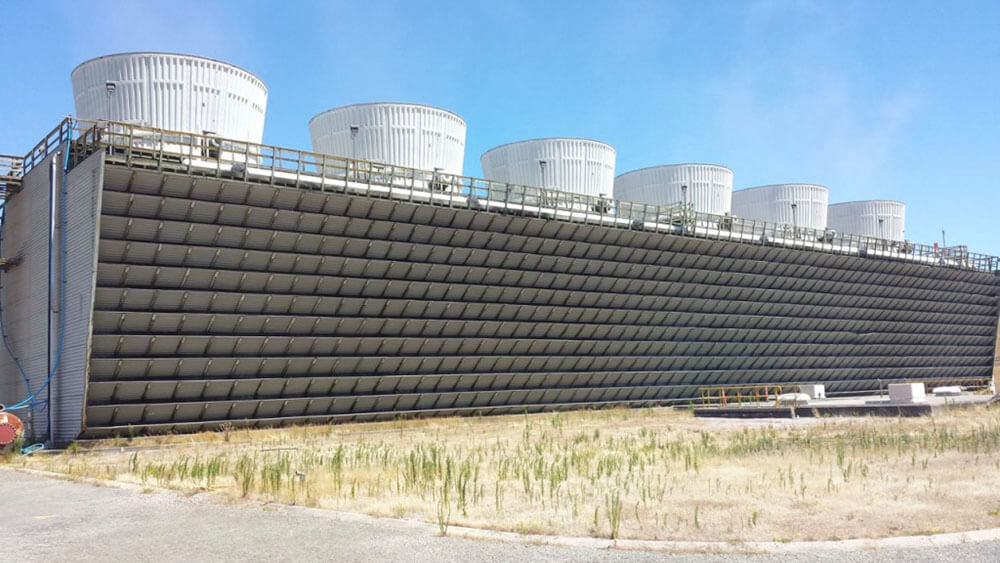
Crossflow towers employ a design where the air moves horizontally, perpendicular to the downward flow of water. This design minimizes the air pressure drop through the tower and can, therefore, operate with lower energy fans compared to counterflow towers. The design leads to larger towers due to the space required for the air to move horizontally across the falling water. Crossflow towers are appreciated for their ease of maintenance as many of the components are easily accessible.
3. Natural Draft Towers
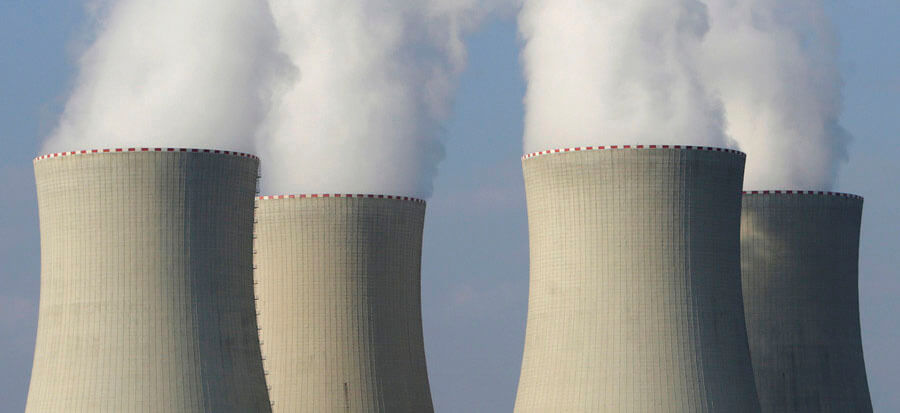
Natural draft towers leverage the principle of buoyancy, where the warm, moist air naturally rises and is discharged into the atmosphere without the need for mechanical fans. These towers are typically quite tall, with their impressive height facilitating this natural “chimney effect.” This design is energy-efficient since it doesn’t require mechanical fans, but the larger size and higher construction costs are significant considerations. They are typically used in large industrial processes where a significant amount of heat needs to be rejected.
4. Mechanical Draft Towers
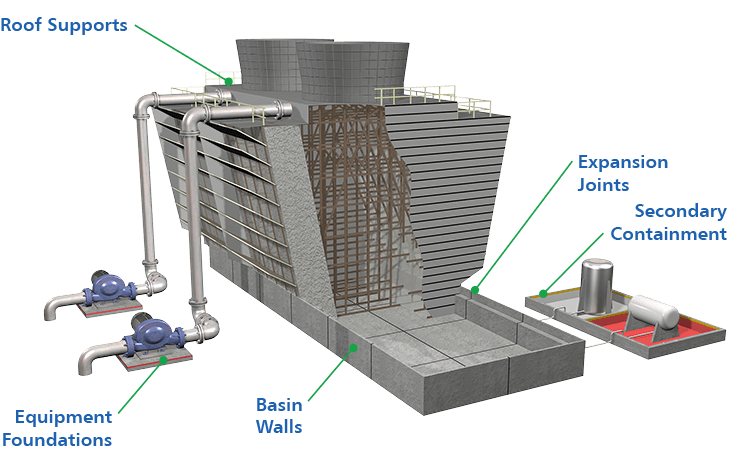
Mechanical draft towers use fans to generate air flow through the tower. Unlike natural draft towers, these designs are not reliant on natural buoyancy for air movement and therefore don’t need to be as tall. They can be designed with either a counterflow or crossflow configuration, making them versatile for various applications. The use of fans allows for control over the air flow rate, enhancing the efficiency of heat rejection. However, these towers will consume more energy due to the use of mechanical fans.
Efficiency and Maintenance of Cooling Towers
Proper maintenance is the key to optimizing the efficiency and extending the lifespan of cooling towers. This involves routine inspections, servicing, and preventive measures to identify and resolve potential issues early on. Here’s an overview of the various steps involved in cooling tower maintenance.
Regular Cleaning
Keeping the cooling tower clean is crucial for its optimal operation. This includes cleaning the basin to remove any sediments and preventing algae growth, which could obstruct the water flow and reduce cooling efficiency. In addition, the tower fill media should be kept clean to ensure maximum air-water contact.
Water Treatment
The quality of the water used in the cooling tower directly influences its performance. Regular water treatment, including the use of biocides, algaecides, and scale inhibitors, can prevent issues like corrosion, scaling, and biological growth, which can damage the cooling tower and decrease its effectiveness.
Inspection of Mechanical Components
The mechanical parts of a cooling tower, such as fans, motors, and belts, require regular inspection for any signs of wear and tear. Timely replacement or repair of these parts can prevent breakdowns and maintain the tower’s performance.
Monitoring Cooling Tower Performance
Regular performance monitoring is crucial to ensure the cooling tower is operating as efficiently as possible. This involves tracking key parameters like water flow rate, air flow rate, and cooling capacity, among others. Any significant changes in these parameters could indicate an issue requiring immediate attention.
Seasonal Preparation
As cooling towers are exposed to the elements, they need to be prepared for different seasons. For instance, before the onset of winter, it’s essential to properly winterize the cooling tower to prevent freezing. Conversely, preparing for summer involves ensuring the cooling tower can handle the higher loads associated with warmer weather.
Conclusion
Phew! That’s quite a lot to take in. Who knew cooling towers were so complex and interesting? But remember, like much of our modern world, they’re hidden in plain sight, quietly keeping our industries running smoothly and efficiently. So next time you see that plume of vapor rising into the sky, you’ll know exactly what’s going on. Isn’t learning awesome?
Thank you for taking the time to join us on this journey through the fascinating world of cooling towers. If you found it as interesting as we do, why not share this article with a friend? You might just ignite a lifelong passion for industrial processes – and that’s pretty cool, right?
Author’s Note: Hey, dear reader! I hope you’ve enjoyed this deep-dive into the world of cooling towers as much as I enjoyed writing it. They’re one of those things we don’t think about often, but without them, our world would look very different. Here’s to the unsung heroes of the industrial world – the cooling towers. Stay curious, and keep asking questions. Who knows what you’ll discover next?

Thanks for pointing out that the fill media in cooling towers have to be kept clean so that there is maximum air-water contact. I can imagine the importance of handling and maintaining those things when it comes to cooling tower processes to prevent issues in their processes. It might also have an effect on the safety of the workers in the vicinity when all components are not contaminated and functioning properly, in my opinion.
Há alguma poluição causada pelo uso da torre de resfriamento?
Sim, o uso de torres de resfriamento pode causar certos tipos de poluição, embora sejam amplamente utilizadas para dissipar o calor de processos industriais ou sistemas de refrigeração. Os principais tipos de poluição associados às torres de resfriamento incluem:
Poluição Térmica: As torres de resfriamento liberam calor no meio ambiente, o que pode elevar a temperatura de corpos d’água próximos, afetando a vida aquática e o ecossistema local.
Poluição da Água: O processo de evaporação na torre de resfriamento pode concentrar e liberar substâncias químicas na água de descarte, potencialmente poluindo fontes de água. Além disso, o tratamento de água das torres pode incluir biocidas e outros produtos químicos que, se não forem manuseados corretamente, podem contaminar as águas superficiais ou subterrâneas.
Poluição do Ar: Embora menos comum, as torres de resfriamento podem emitir vapor d’água, que sob certas condições pode contribuir para a formação de nevoeiro ou nuvens. Além disso, se a água utilizada contiver substâncias químicas voláteis, essas podem ser liberadas na atmosfera. Em casos de sistemas mal geridos ou com tecnologia ultrapassada, pode haver emissão de legionella, bactéria responsável pela doença do legionário, através dos aerossóis produzidos pela torre.